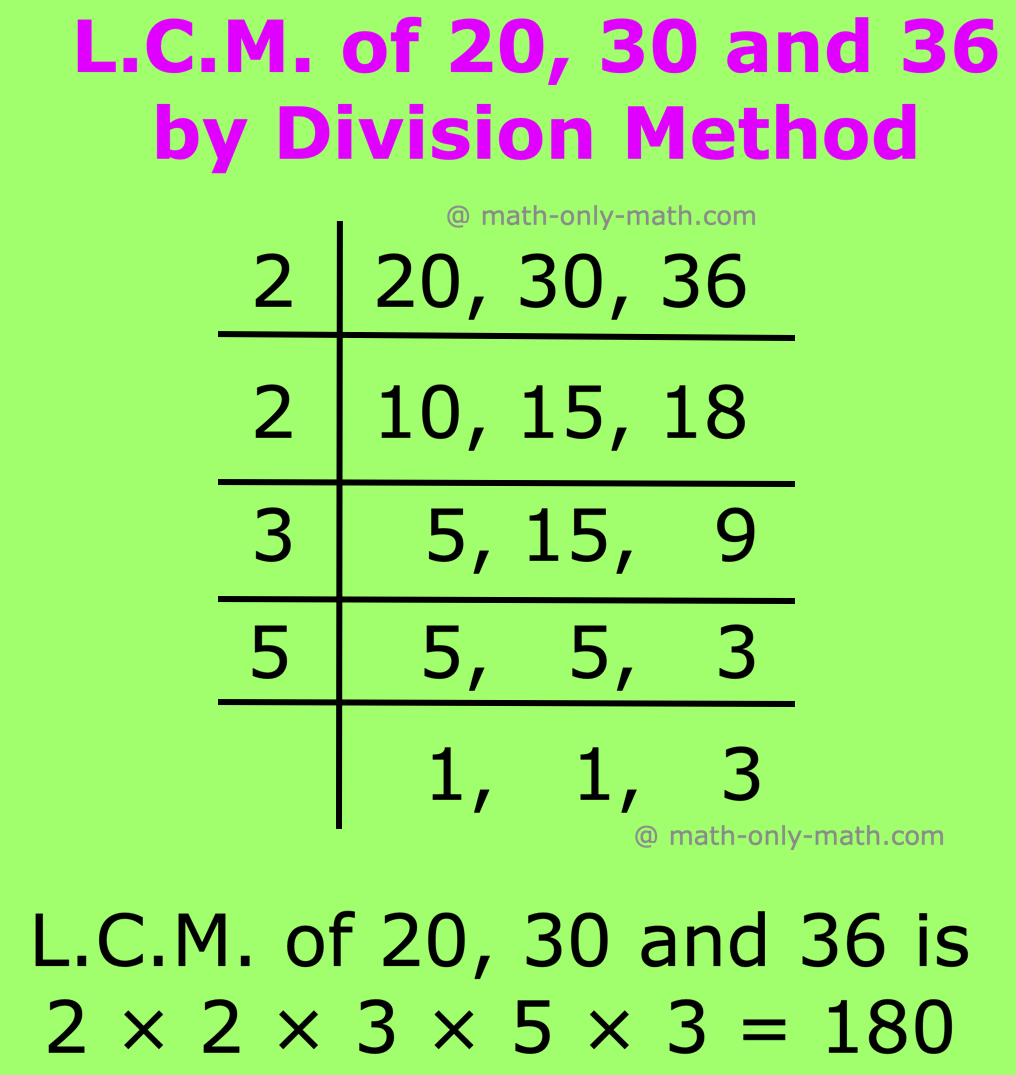Subscribe to our ▶️ YouTube channel 🔴 for the latest videos, updates, and tips.
5th Grade Least Common Factor (L.C.M.)
We already familiar with the least common multiple which is the smallest common multiple of the numbers. The least (lowest) common multiple of two or more numbers is exactly divisible by each of the given numbers.
Let us consider two numbers 12 and 15.
Multiples of 12 = 12, 24, 36, 48, 60, 72, 84, 96, 108, 120 etc.
Multiples of 15 = 15, 30, 45, 60, 75, 90, 105, 120 etc Common
multiples of 12 and 15 are 60, 120 etc.
Clearly, the least common multiple is 60.
So, the L.C.M. of 12 and 15 is 60.
We can find the L.C.M. of the given numbers as follows.
I: By Prime Factorisation Method
II: By Division Method
CASE I: Finding the L.C.M. by Prime Factorisation Method:
For Example:
1. Find the L.C.M. of 12, 15 and 24.
Solution:
Prime factors of 12 = 2 × 2 × 3
Prime factors of 15 = 3 × 5
Prime factors of 24 = 2 × 2 × 2 × 3
Here, 2 occurs a maximum number of 3 times and 3 and 5 occur once only
So, the L.C.M. of 12, 15 and 24 is 2 × 2 × 2 × 3 × 5 = 120
CASE II: Finding the L.C.M. By Division Method:
For Example:
1. Find the L.C.M. of 20, 30, 36.
Solution:
So, the L.C.M. of 20, 30, and 36 is 2 × 2 × 3 × 5 × 3 = 180.
NOTE: The L.C.M. of two prime numbers is their product.
For example, the L.C.M. of 3 and 7 is 3 × 7 = 21
If a number is the factor of another number, their L.C.M. is the greater number itself.
For example, the L.C.M. of 6 and 12 is 12.
Worksheet on 5th Grade Least Common Factor (LCM)
I. Find the L.C.M. of the following numbers by prime factorisation method.
1. 8 and 12
2. 90 and 180
3. 36 and 64
4. 44, 120 and 132
5. 24, 62 and 124
6. 180, 192 and 576
7. 36, 92 and 164
8. 20, 125 and 145
9. 18, 24 and 36
10. 14, 21 and 49
11. 27, 45 and 63
12. 50, 90 and 120
13. 38, 76 and 152
14. 28, 42 and 70
15. 60, 90 and 130
Answer:
I. 1. 24
2. 180
3. 64
4. 1320
5. 744
6. 2880
7. 33948
8. 14500
9. 72
10. 294
11. 945
12. 1800
13. 152
14. 420
15. 2340
II. Find the L.C.M. of following numbers by division method.
1. 24, 36 and 48
2. 8, 12 and 20
3. 68, 102 and 119
4. 15, 21 and 28
5. 55, 88 and 110
6. 39, 65 and 52
7. 66, 88 and 99
8. 54, 112 and 120
9. 56, 64 and 84
10. 63, 84 and 105
11. 60, 72 and 120
12. 95, 120 and 288
13. 225, 400 and 625
14. 78, 230 and 260
15. 120, 230 and 340
Answer:
II. 1. 144
2. 120
3. 1428
4. 420
5. 440
6. 780
7. 792
8. 15120
9. 1344
10. 1260
11. 360
12. 27360
13. 90000
14. 17940
15. 46920
5th Grade Math Problems
From 5th Grade Least Common Factor (LCM) to HOME PAGE
Didn't find what you were looking for? Or want to know more information about Math Only Math. Use this Google Search to find what you need.



New! Comments
Have your say about what you just read! Leave me a comment in the box below. Ask a Question or Answer a Question.